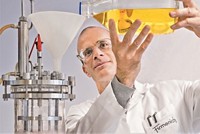Advertisement
Grab your lab coat. Let's get started
Welcome!
Welcome!
Create an account below to get 6 C&EN articles per month, receive newsletters and more - all free.
It seems this is your first time logging in online. Please enter the following information to continue.
As an ACS member you automatically get access to this site. All we need is few more details to create your reading experience.
Not you? Sign in with a different account.
Not you? Sign in with a different account.
ERROR 1
ERROR 1
ERROR 2
ERROR 2
ERROR 2
ERROR 2
ERROR 2
Password and Confirm password must match.
If you have an ACS member number, please enter it here so we can link this account to your membership. (optional)
ERROR 2
ACS values your privacy. By submitting your information, you are gaining access to C&EN and subscribing to our weekly newsletter. We use the information you provide to make your reading experience better, and we will never sell your data to third party members.
Food Science
Movers And Shakers
Greg Yep has big plans for IFF’s team of 1,600 scientists
The R&D chief says the flavor and fragrance firm’s big growth moves give him all the ingredients for success
by Melody M. Bomgardner
April 23, 2021
| A version of this story appeared in
Volume 99, Issue 15

Greg Yep has worked all over the food and fragrance industry and traveled the world to learn about ingredients ranging from algae to vanilla. An organic chemist, Yep leads the R&D and sustainability group at International Flavors & Fragrances, based in New York City. And his job just got bigger—a lot bigger.
Vitals
▸ Hometown: Baltimore
▸ Studies: BA, chemistry and biology, University of Pennsylvania, 1987; PhD, organic chemistry, Johns Hopkins University, 1993
▸ Favorite drink: Unsweetened ice tea
▸ Strangest work assignment: Filming a television special about natural products in remote areas of China
▸ Hobby: Collecting and refurbishing pinball machines
▸ Favorite molecule: Buckyball
In February, IFF wrapped up its merger with the Nutrition and Biosciences business of DuPont—a deal that more than doubled IFF’s size to over $11 billion in annual sales. Yep’s team also more than doubled to 1,600 scientists. His team, which once concentrated mainly on taste and fragrance, is now responsible for helping four divisions cook up a diverse menu of ingredients for food, beverages, health products, and many other kinds of consumer goods.
IFF pursued the DuPont deal to grow not just larger but also more profitable. Since the two companies shared many of the same customers, investors will be watching to see if the new IFF can both find business synergies and create new ingredients that customers will pay more for. One investor, Scott Ferguson, managing director of the hedge fund Sachem Head, pressured IFF into giving him a seat on its board to ensure IFF achieves the substantial financial benefits it promised.
Yep says IFF is ready to go after big growth opportunities. He has high-value alternative proteins, active cosmetic ingredients, and new scent and taste technologies in his sights, thanks to DuPont’s capabilities. One strategy he will pursue is to help IFF’s customers create next-generation products by developing well-thought-out ingredient combinations for each application. “How do we put those ingredients together in a way that 1 plus 1 equals 10?” Yep asks.
The company’s portfolio includes nearly every specialty ingredient that goes into products on grocery and drugstore shelves: texturants like pectin, alginates, and carrageenan; probiotics; binders; proteins; emulsifiers; nutraceuticals; pharmaceutical excipients; and tastes, flavors, and scents.
A decade of consolidation in the food ingredient industry has led to this moment at IFF. In 2018, IFF absorbed Frutarom after the Israeli firm spent the prior years expanding its own global footprint in flavors and fragrances, mainly through acquisition. In 2017, DuPont took on FMC’s health and nutrition ingredient businesses in a swap for FMC’s pesticide business. Shortly after, DuPont became the new home of Dow’s cellulosic business. And much of DuPont’s capabilities in enzymes and probiotics originated at Danisco, which it snapped up back in 2011.
That adds up to a lot of expertise now in Yep’s department. “You can imagine with veterans from Danisco, FMC, Dow, DuPont, and Frutarom, there’s just a lot of experience out there,” he says. “The exciting news is, they’re not just the top scientists at IFF but in the whole industry. I’ve met people whose names I’ve been reading on publications my entire career.”
Yep’s first priority is to bring together two R&D organizations that were sizable in their own rights. “Not only do we have to meet together and make sure our culture is right,” he says, “but we also have to integrate our technologies in the right way to make sure our scientists and folks in R&D are in the right positions at the right time.” Yep says his new team can tackle problems that haven’t been solved yet, like combining texture, taste, and nutritional ingredients to make convincing alternatives to meat that are also healthier.
Now is also the time, Yep says, to prepare IFF’s laboratories for the future. As a company, IFF has embraced artificial intelligence. With the additional resources Yep now has at hand, he plans to set up systems that efficiently use AI, cloud computing, and robotics to do a lot of the hard work of creating new scent and taste ingredients.
Yep says he expects a lot from these new lab and data automation technologies. “What can I do with data to make better decisions, to make sure all of our data is transparent for our scientists to use so we can put our creations, our art, and our science together?”
Automation is not the only new technology transforming IFF. Biotechnology has brought scientists new methods for discovering, developing, and manufacturing high-value compounds, including flavors and aromas.
Being able to produce ingredients via fermentation from inexpensive feedstocks such as sugar will make it easier to cost-effectively deliver the sustainable ingredients that IFF’s customers demand, Yep notes, particularly as food and personal care companies shift away from their reliance on substances extracted from rare plants or made with synthetic chemicals.

Yep says he feels OK, as a chemist, about turning to biology to make molecules. It’s perhaps a natural progression for a PhD organic chemist who has spent 30 years in the food industry. “Nature does its own chemistry,” Yep points out. “When you look at what nature does in a plant like stevia—whether a plant uses an enzyme or I use a catalyst, it is still organic chemistry.”
Yep started in the industry right after getting his PhD at Johns Hopkins University. He first worked at a McCormick spice manufacturing plant in Maryland and later led the company’s flavor lab.
He went on to build his nutrition and product application skills as senior vice president of R&D at PepsiCo. “The reason I joined PepsiCo is I wanted to see the other side—to be the receiver of the technology at a big brand,” Yep says. The experience helped Yep learn how beverages and snacks are formulated.
Yep started using biotech at the flavor and fragrance firm Givaudan as a vice president of global applications technology to identify taste receptors and develop new ways to produce molecules. And by the time he arrived at IFF in 2016, the company had embarked on its collaboration with the biotech firm Evolva to make vanillin via fermentation.
“Biotech has advanced so rapidly, it now allows me to do reactions, like dehydration of tertiary alcohol, I couldn’t do before via synthetic methods,” Yep says.
Yep reels off the businesses within IFF that his biotechnology experts will work with: health and nutrition products, probiotics, pharmaceutical delivery, and food, beverage, and fragrance ingredients.
Although IFF’s R&D team is expected to help those businesses serve their customers, its purview also extends to basic research, such as studying how humans perceive and respond to the molecules around them. Yep cites basic and applied olfactory research as one area for growth.
“We’re using what we’ve learned in taste to discover what’s happening in the olfactory receptors. For example, as many as 70% of COVID-19 patients lose their taste and smell. Why is that? Is it an inflammation system?” IFF worked with scientists at Massachusetts General Hospital and Harvard University to create one of the first smell tests for COVID-19.
Yep sees a lot of white space in sensory science to explore. “Scent is very powerful—it can bring back memories, trigger thought processes, help you sleep, help your wellness.” He’d like to know if it can also affect cognition, immunity, or even athletic performance.
Understanding olfaction can also help IFF find new ways to combat malodor. It’s a complicated topic, Yep says, because each bad smell has its own chemistry. One opportunity he sees is to combat smells in cities with high levels of air pollution, where compounds can settle on clothes and skin. Fighting such odors on the skin requires understanding the role of the skin microbiome, Yep points out.
Similarly, Yep has beefed up the company’s clinical team to research the link between skin and gut microbes and to obtain credible evidence backing the efficacy of probiotics, strains of microbes intended to provide health benefits. “The science makes sense to us—the evidence of the benefits to the consumer is growing,” Yep says. “I believe it is the future. There’s probably no application I can think of that a probiotic would not touch.”
Yep says he is already taking advantage of the deep expertise he now has access to. For example, he’s assembled a group of 40 IFF fellows he considers the top scientists in the industry.
“They can help out on any type of challenge; we can put them on anything and they have new things they want to try,” Yep says. “If I want to know about probiotics, there’s someone that has worked on that for 30 years and has the answers.”





Join the conversation
Contact the reporter
Submit a Letter to the Editor for publication
Engage with us on Twitter